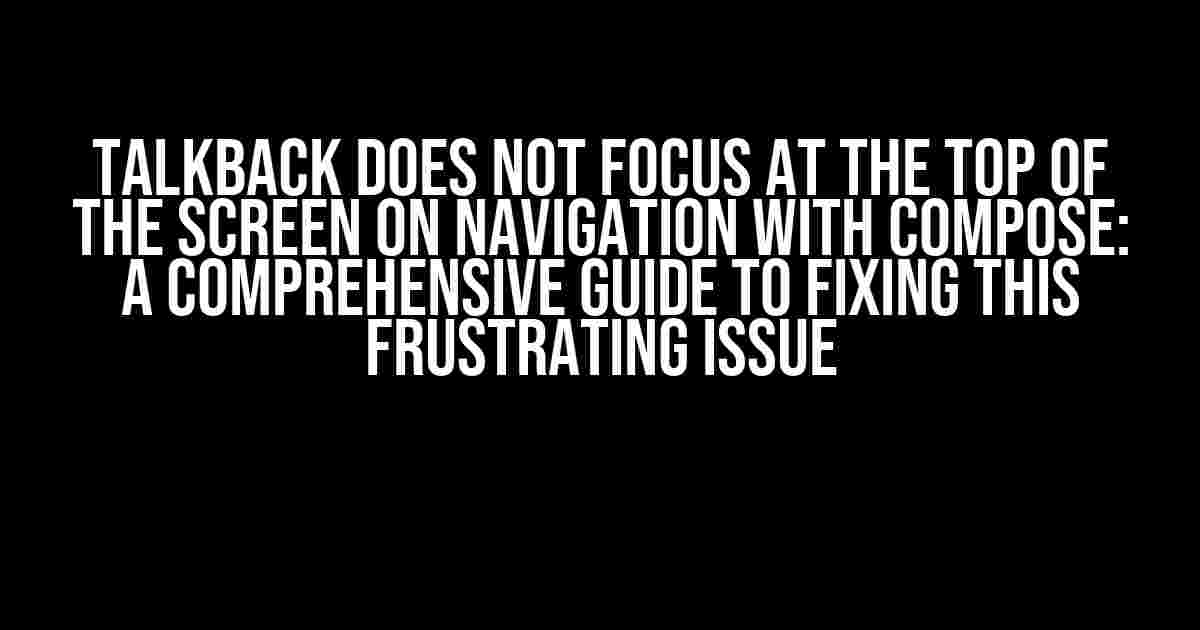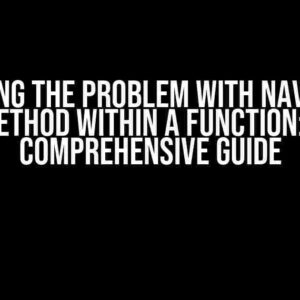Are you tired of dealing with Talkback refusing to focus at the top of the screen when navigating with Compose? You’re not alone! This pesky issue has been plaguing Android developers for far too long, leaving users frustrated and confused. Fear not, dear reader, for today we’re going to dive deep into the world of accessibility and Compose to provide a step-by-step solution to this infuriating problem.
Understanding the Problem: What’s Going On?
Before we dive into the fix, it’s essential to understand the root cause of this issue. When using Talkback with Compose, the screen reader is supposed to focus on the topmost element of the screen, allowing users to navigate seamlessly. However, in some cases, Talkback fails to do so, leaving users stuck in an endless loop of frustration.
The Role of Compose in Accessibility
Compose, a powerful UI toolkit for Android, is designed to provide a seamless and intuitive user experience. However, when it comes to accessibility, Compose can sometimes fall short. By default, Compose doesn’t provide a clear indication of which element should receive focus when the screen is navigated. This lack of clarity can lead to Talkback’s confusion, causing it to fail to focus at the top of the screen.
The Fix: A Step-by-Step Guide
Don’t worry, dear reader; we’re about to embark on a journey to fix this issue once and for all! Follow these simple steps to ensure Talkback focuses correctly at the top of the screen on navigation with Compose:
Step 1: Add Accessibilityannotations to Your Compose Code
The first step in resolving this issue is to add accessibility annotations to your Compose code. These annotations provide crucial information to Talkback, helping it understand which elements should receive focus. Update your Compose code to include the following annotations:
import androidx.compose.foundation.layout.Column
import androidx.compose.foundation.layout.fillMaxWidth
import androidx.compose.foundation.layout.padding
import androidx.compose.material.MaterialTheme
import androidx.compose.material.Text
import androidx.compose.runtime.Composable
import androidx.compose.ui.Modifier
import androidx.compose.ui.accessibility.AccessibilityAnnotation
import androidx.compose.ui.accessibility.Accessibility_annotations
@Composable
fun MyScreen() {
Column(
modifier = Modifier
.fillMaxWidth()
.padding(horizontal = 16.dp)
) {
Text(
text = "Hello, World!",
style = MaterialTheme.typography.h1,
modifier = Modifier.accessibilityAnnotation(
AccessibilityAnnotation(
accessibilityRole = AccessibilityAnnotation.Role.HEADLINE
)
)
)
}
}
In this example, we’ve added the `accessibilityAnnotation` modifier to our `Text` composable, specifying the role of the element as a headline. This annotation provides Talkback with the necessary information to correctly focus on the topmost element.
Step 2: Implement Custom AccessibilityDelegate
The next step is to implement a custom accessibility delegate to handle focus events. This delegate will ensure that Talkback receives the correct information about which element should receive focus. Create a new class that extends `AccessibilityDelegate` and override the `performAccessibilityAction` method:
import androidx.compose.ui.accessibility.AccessibilityDelegate
import androidx.compose.ui.accessibility.AccessibilityNode
class CustomAccessibilityDelegate : AccessibilityDelegate() {
override fun performAccessibilityAction(
action: Int,
arguments: Bundle?
): Boolean {
// Implement custom logic to handle focus events
when (action) {
AccessibilityNode.ACTION_SCROLL_FORWARD -> {
// Handle scroll forward action
}
AccessibilityNode.ACTION_SCROLL_BACKWARD -> {
// Handle scroll backward action
}
else -> {
// Handle other actions
}
}
return super.performAccessibilityAction(action, arguments)
}
}
In this example, we’ve created a custom accessibility delegate that overrides the `performAccessibilityAction` method to handle focus events. You can implement custom logic to handle specific actions, such as scrolling forward or backward.
Step 3: Register the Custom AccessibilityDelegate
Now that we’ve created our custom accessibility delegate, it’s time to register it with Compose. Update your Compose code to register the delegate:
import androidx.compose.ui.accessibility.AccessibilityDelegate
@Composable
fun MyScreen() {
val customAccessibilityDelegate = CustomAccessibilityDelegate()
CompositionLocalProvider(
LocalAccessibilityDelegate provides customAccessibilityDelegate
) {
// Your Compose code here
}
}
In this example, we’ve registered our custom accessibility delegate with Compose using the `CompositionLocalProvider` composable. This ensures that Talkback receives the correct information about which element should receive focus.
Testing and Verification
Now that we’ve implemented the fix, it’s essential to test and verify that Talkback correctly focuses at the top of the screen on navigation with Compose.
Enable Talkback and Compose
To test the fix, enable Talkback on your Android device and navigate to the screen containing your Compose UI. Ensure that Talkback is properly configured and enabled.
Verify Focus Behavior
Use the Talkback navigation keys to navigate to the topmost element of the screen. Verify that Talkback correctly focuses on the element and announces its content. If Talkback fails to focus or announces incorrect content, revisit the steps above and ensure that the fix is properly implemented.
Conclusion
In conclusion, fixing the issue of Talkback not focusing at the top of the screen on navigation with Compose requires a combination of accessibility annotations, custom accessibility delegates, and proper registration. By following the steps outlined in this guide, you can ensure that Talkback correctly focuses on the topmost element, providing a seamless and accessible user experience for your users.
| Step | Description |
|---|---|
| 1 | Add accessibility annotations to your Compose code |
| 2 | Implement a custom accessibility delegate to handle focus events |
| 3 | Register the custom accessibility delegate with Compose |
Remember, accessibility is an essential aspect of Android development, and by following these steps, you can ensure that your app provides a world-class user experience for all users.
- Use accessibility annotations to provide crucial information to Talkback
- Implement a custom accessibility delegate to handle focus events
- Test and verify the fix using Talkback
By following this comprehensive guide, you’ll be well on your way to resolving the frustrating issue of Talkback not focusing at the top of the screen on navigation with Compose. Happy coding!
- Compose: A UI toolkit for Android
- Talkback: A screen reader for Android
- Accessibility annotations: Providing crucial information to Talkback
Stay tuned for more articles on Android development, accessibility, and Compose. If you have any questions or need further clarification on this topic, feel free to ask in the comments below!
Here are 5 Questions and Answers about “Talkback does not focus at the top of the screen on navigation with Compose” in a creative voice and tone:
Frequently Asked Question
Get answers to the most frequently asked questions about Talkback focus issues on navigation with Compose.
Why does Talkback not focus at the top of the screen when I navigate with Compose?
Talkback not focusing at the top of the screen when navigating with Compose is a common issue. This happens because Compose doesn’t automatically move the focus to the top of the screen when navigating. To fix this, you can use the `focusManager` to manually set the focus to the top of the screen.
Is this a Compose-specific issue or a general Android issue?
This is a general Android issue, not specific to Compose. Talkback navigation works differently on Android, and this issue can occur even without using Compose. However, using Compose’s `focusManager` can help resolve the issue.
How can I request focus on a specific element when navigating with Talkback?
You can request focus on a specific element by using the `requestFocus` function provided by the `focusManager`. This allows you to set the focus to a specific element, such as a button or a text field, when the user navigates to it with Talkback.
Will setting the focus to the top of the screen affect the user’s experience?
Setting the focus to the top of the screen when navigating with Talkback can actually improve the user’s experience. It helps users who rely on Talkback to navigate more efficiently and ensures that they can easily access the top-most elements on the screen.
Are there any other ways to improve Talkback navigation with Compose?
Yes, there are several other ways to improve Talkback navigation with Compose. For example, you can use `contentDescription` to provide a description of the element for Talkback users, or use `android:accessible` to make elements more accessible. You can also use `semantics` to provide additional information about the element’s purpose and behavior.


